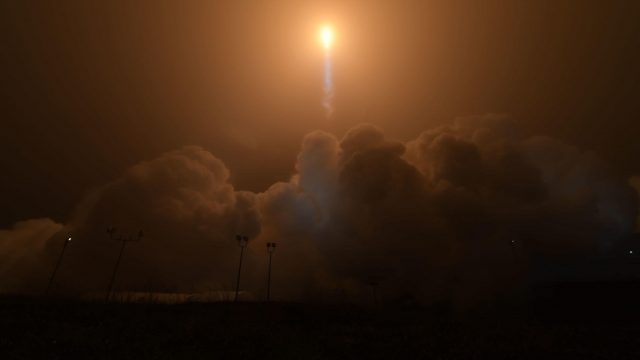
This week’s entry: Mars 2020
What it’s about: Mars! The Angry Red Planet. The “Show Me” Planet. Land Of Lincoln. 2020 is going to be a big year for everyone’s favorite non-gas-giant non-Earth planet, as NASA is launching the next in its increasingly ambitious series of Mars rovers.
Biggest controversy: We’re almost certainly going to have another Boaty McBoatface on our hands. Last fall, NASA had a naming contest, because no one seems to ever learn the lesson that you shouldn’t let the public decide anything. They were at least smart enough to include a “judging period,” so some cooler head will weed out entries like “Dr. Roverpants, DDS” and “Marz Nutz” before presenting the finalists to the public. (Which happens later this month according to NASA’s website).
Strangest fact: We’re not just sending a rover, we’re also sending a helicopter. Dr. Roverpants will carry with it Mars Helicopter Scout, a solar-powered drone that can scout ahead to look for easier routes for the rover to drive. Before you dust off the spec script for Airwolf In Space you wrote in the late ’80s, you should know the helicopter only plans to fly for three minutes a day. Because Mars’ atmosphere is thin (0.628% Earth’s average surface air pressure), it’s not clear helicopter rotors will even work, so the Scout’s primary function is to let NASA see what goes wrong so they can build a better drone next time.
Thing we were happiest to learn: The rover will look both to the past and the future. While most of 2020’s time will be spent studying soil and rock samples to look for signs of past Martian life, part of its mission will be storing and preserving those samples as if they were going to return to Earth. Doing so lays the groundwork for a future mission that does in fact return samples to Earth, which in turn paves the way for sending and returning astronauts to Earth. A small step for roverkind, but one firmly in the direction of a manned Mars mission.
Thing we were unhappiest to learn: Mars 2020 isn’t going to land until 2021. Summer 2020 is the launch date, but the eight-to-nine-month journey means the rover won’t land until early next year. The planned mission is nearly two years (669 days, or one Mars year), but given that Curiosity’s mission was scheduled to end on 2014 and it’s still going strong, NASA must have high-hopes for a longer run for 2020 as well.
Also noteworthy: For those of you who read the article but don’t click through to the Wikipedia page, make an exception this time, as there’s a terrific set of photos showing NASA’s rover assembly room, the testing and construction of the rover, and the landing site. There’s also a topographic map of the planet, with landing sites for Mars missions going back to 1971 and the Soviet Union’s Mars 2.
After that, scroll down to the very bottom and the “Future spaceflights” tab for a comprehensive schedule of every mission to leave Earth in the next 15 years. 2020 includes manned missions from Russia, China, SpaceX, Boeing, Blue Origin (Jeff Bezos’ spaceflight company), and Virgin Galactic. 2021 will see the launch of Gaganyaan, India’s first manned space mission, (although not India’s first astronaut, as Rakesh Sharma was part of Russia’s Soyuz T-11 mission in 1984.)
Best link to elsewhere on Wikipedia: Mars 2020 won’t be the only Mars rover launched this summer. A joint European-Russian mission is launching Rosalind Franklin (formerly ExoMars), on a similar mission to look for past signs of life on the red planet. The ESA/Roscomos mission also held a naming contest, which chose Dr. Franklin, an English scientist whose work on the molecular structure of everything from DNA to coal to viruses is slightly more significant than that of her American counterpart, Dr. Roverpants.
The United Arab Emirates is also launching the Hope Mars Mission during that same summer launch window, the first from any Middle Eastern country. Hope plans to spend two years modeling the Martian atmosphere, in part to try and understand why the planet shed so much of its atmosphere—at some point in the past, Mars had an Earth-like atmosphere able to sustain liquid water—and why it continues to bleed atmosphere into space to this day.
Further down the wormhole: NASA doesn’t just have a space helicopter—it also has its own TV station. NASA TV is a public-domain TV channel broadcast by satellite and over the internet, which some local cable companies also opt to carry. It airs science and educational programming, as well as live footage of space launches, and footage from the International Space Station. The NASA TV page has a tab for U.S. broadcast TV networks, of which there are a surprising number. Besides the five major networks, PBS, and retro channels like Ion and MyNetworkTV, there are over-the-air classic movie networks, home shopping, and international channels reaching out to the U.S. market, like Deutsche Welle.
The DW is a state-run (think the BBC, not Russian state TV) German network that broadcasts worldwide in 30 languages. DW airs under the banner of ARD, originally a West German network of public broadcasters that produced series like Raumpatrouille (a 1966 Star Trek-like show that was the first sci-fi on German TV), Sesamstrasse (Germany’s edition of Sesame Street), and Beat-Club. The later was a music show that ran from 1965 to 1972 and featured everyone from Chuck Berry to Bowie to the Grateful Dead to the MC5 to a quartet of young skiffle musicians who left Liverpool to play in Hamburg, the Liverbirds. We’ll look at the Beatles’ largely forgotten female contemporaries next week.





























